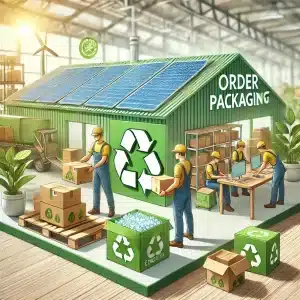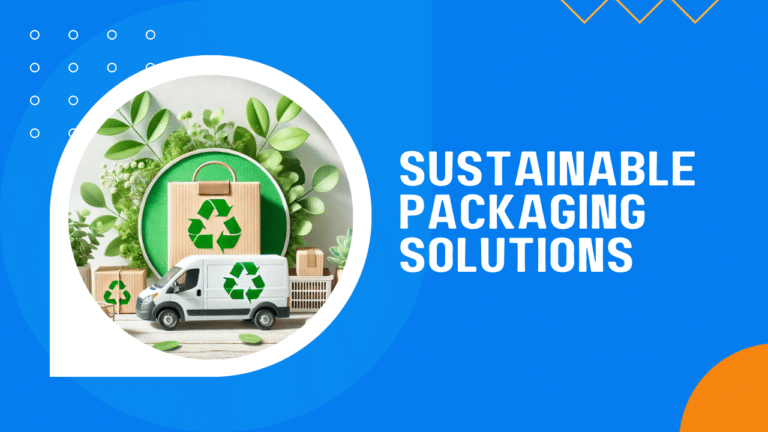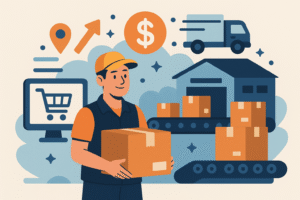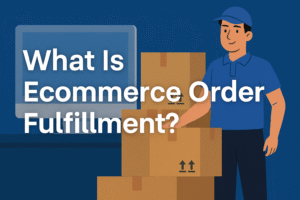Sustainability is rapidly becoming a critical priority for businesses across all sectors, including ecommerce. As online shopping continues to grow, the environmental impact of packaging is under increasing scrutiny. Traditional packaging materials, such as single-use plastics and non-recyclable components, contribute significantly to pollution and waste. This reality underscores the urgent need for sustainable packaging solutions.
Sustainable packaging offers a way to reduce this environmental footprint by using eco-friendly materials, minimizing waste, and lowering carbon emissions. For ecommerce store owners, adopting sustainable packaging isn’t just about protecting the planet; it also enhances brand image, boosts customer loyalty, and ensures compliance with evolving environmental regulations.
This article will provide you with practical insights into various eco-friendly packaging options, design principles for sustainable packaging, and steps to implement these solutions effectively in your business. By the end of this article, you’ll be equipped with the knowledge to make informed decisions about sustainable packaging and help drive positive change for both your business and the environment.
What is Sustainable Packaging
Sustainable packaging refers to the development and use of packaging solutions that have a minimal environmental impact and footprint. This approach is centered around several key principles:
- Reducing Waste: Sustainable packaging aims to minimize waste throughout the product lifecycle. This includes designing packaging that uses fewer materials, is more efficient to produce, and generates less waste during production and after use.
- Using Eco-Friendly Materials: The materials used in sustainable packaging are renewable, biodegradable, or recyclable. This reduces reliance on non-renewable resources like petroleum-based plastics and helps decrease the overall environmental impact.
- Minimizing Carbon Footprint: Sustainable packaging solutions are designed to lower greenhouse gas emissions. This can be achieved by using lightweight materials that reduce transportation emissions, optimizing packaging designs to improve energy efficiency, and sourcing materials locally to cut down on shipping distances.
The benefits of adopting sustainable packaging for ecommerce businesses are significant:
- Enhanced Brand Image: Consumers are increasingly aware of environmental issues and prefer brands that demonstrate a commitment to sustainability. Using sustainable packaging can enhance your brand’s reputation and attract eco-conscious customers.
- Customer Loyalty: Providing sustainable packaging options can lead to increased customer satisfaction and loyalty. Customers appreciate companies that align with their values and are more likely to return to a business that prioritizes environmental responsibility.
- Regulatory Compliance: Governments around the world are implementing stricter regulations on packaging waste and materials. Adopting sustainable packaging helps ensure compliance with current and future regulations, avoiding potential fines and legal issues.
Sustainable packaging is not just an environmental imperative; it is also a strategic business decision that can drive customer engagement and operational efficiency. In the next section, we will explore the different types of sustainable packaging materials available to ecommerce store owners.
Types of Sustainable Packaging Materials
Implementing sustainable packaging begins with choosing the right materials. Here are some of the most effective and eco-friendly options available for ecommerce businesses:

1. Recycled Paper and Cardboard
Recycled paper and cardboard are among the most commonly used sustainable packaging materials. They are derived from post-consumer and post-industrial waste, making them a resource-efficient option.
- Availability: Widely available and easily sourced, recycled paper and cardboard are versatile and can be used for various packaging needs, from shipping boxes to product wraps.
- Cost-Effectiveness: These materials are generally cost-effective, especially when purchased in bulk, making them an economical choice for businesses of all sizes.
- Environmental Benefits: Using recycled materials reduces the demand for virgin paper, conserving trees and reducing water and energy consumption during production.
2. Bioplastics
Bioplastics are derived from renewable resources such as corn starch, sugarcane, and potato starch. They offer an alternative to traditional petroleum-based plastics.
- Renewable Resources: Bioplastics are made from plant-based materials, reducing dependency on fossil fuels and lowering carbon emissions.
- Versatility: These materials can be molded into various forms, from bags and containers to packaging films, providing flexibility for different packaging requirements.
- Environmental Impact: Bioplastics are often compostable and biodegradable, which means they break down naturally in the environment, reducing plastic pollution.
3. Plant-Based Packaging
Innovative plant-based packaging materials are gaining popularity for their sustainability and unique properties.
- Mushroom Packaging: Made from agricultural waste and mycelium, mushroom packaging is fully biodegradable and compostable. It is suitable for protective packaging and cushioning.
- Seaweed Packaging: Seaweed-based materials are used for creating edible and compostable packaging, ideal for single-use items.
- Cornstarch Packaging: Cornstarch-based materials are a versatile option that can be used for various packaging needs. They are biodegradable and can decompose in industrial composting facilities.
4. Compostable Packaging
Compostable packaging is designed to break down into non-toxic components in composting environments, leaving no harmful residues.
- Advantages: Compostable packaging helps reduce landfill waste and can enrich soil when composted properly. It is a preferred choice for environmentally conscious consumers.
- Examples of Use: Several companies have successfully integrated compostable packaging into their operations. For instance, the clothing brand Patagonia uses compostable bags for shipping their products, enhancing their sustainability credentials.
By incorporating these sustainable packaging materials into your ecommerce operations, you can significantly reduce your environmental footprint while meeting the growing demand for eco-friendly products. In the next section, we will delve into the design principles for creating effective sustainable packaging.
Design Principles for Sustainable Packaging
Creating sustainable packaging is not just about choosing the right materials; it’s also about implementing smart design principles that further minimize environmental impact. Here are some key principles to consider:
1. Minimalism
Minimalist packaging focuses on using the least amount of material necessary to protect the product. This approach helps reduce waste and lowers production and shipping costs.
- Benefits: By minimizing packaging materials, businesses can decrease their carbon footprint and resource consumption. It also leads to simpler and more efficient packing processes.
- Examples: Many companies are adopting minimalist designs, such as using smaller boxes, reducing filler materials, and opting for single-material packaging that is easier to recycle.
2. Modularity and Flexibility
Modular and flexible packaging designs can adapt to different product sizes and shapes, reducing the need for multiple packaging types.
- Advantages: This approach reduces inventory complexity and waste, as one packaging solution can be used for various products. It also streamlines the packing process, making it more efficient.
- Examples: Companies like IKEA use modular packaging designs that allow them to pack different products in the same type of box, optimizing space and reducing the number of different packaging materials needed.
3. Reusability
Designing packaging that can be repurposed or reused by customers adds value and reduces waste. Reusable packaging encourages a circular economy, where materials are kept in use for as long as possible.
- Customer Engagement: Offering reusable packaging can enhance customer experience and loyalty, as customers appreciate the added value and functionality.
- Examples: Several ecommerce brands offer reusable packaging solutions. For instance, Loop, a zero-waste shopping platform, provides products in durable containers that customers return for reuse, drastically cutting down on single-use packaging.
By incorporating these design principles, ecommerce businesses can create packaging that is not only sustainable but also cost-effective and appealing to customers. In the next section, we will explore practical steps for implementing sustainable packaging solutions in your business.
Implementing Sustainable Packaging Solutions

Adopting sustainable packaging requires a thoughtful approach that considers current practices, sourcing, education, and continuous improvement. Here’s how ecommerce businesses can implement sustainable packaging solutions effectively:
1. Assessing Packaging Needs
Before making any changes, evaluate your current packaging practices to identify areas for improvement.
- Current Practices: Conduct an audit of your existing packaging materials and processes. Identify which materials generate the most waste and have the highest environmental impact.
- Areas for Improvement: Look for opportunities to reduce material usage, switch to more sustainable options, and optimize packaging design for efficiency.
2. Sourcing Sustainable Materials
Partnering with suppliers who provide certified eco-friendly materials is crucial for a successful transition to sustainable packaging.
- Finding Suppliers: Research and connect with suppliers that offer a range of sustainable materials, such as recycled paper, bioplastics, and plant-based packaging. Verify their certifications to ensure the materials meet environmental standards.
- Negotiating Terms: Establish long-term relationships with suppliers to negotiate better pricing and ensure a consistent supply of sustainable materials.
3. Educating Customers
Informing customers about your sustainable packaging efforts is key to gaining their support and ensuring proper disposal.
- Communication: Clearly communicate your sustainable packaging initiatives through your website, social media, and product packaging. Highlight the environmental benefits and provide information on how to recycle or compost the materials.
- Engagement: Encourage customers to participate in your sustainability efforts. This can include offering incentives for returning reusable packaging or providing resources for proper disposal.
4. Monitoring and Improvement
Implementing sustainable packaging is an ongoing process that requires regular assessment and adjustment.
- Continuous Assessment: Regularly review your packaging practices to identify new opportunities for improvement. This can involve tracking waste reduction, customer feedback, and supplier performance.
- Adapting to Changes: Stay informed about new sustainable packaging technologies and materials. Be willing to adapt your strategies as better options become available.
By following these steps, ecommerce businesses can successfully transition to sustainable packaging, benefiting both their operations and the environment. This proactive approach not only aligns with growing consumer demand for eco-friendly practices but also positions businesses as leaders in sustainability.
Wrapping Up
Sustainable packaging is not just a trend; it is a necessary shift for the future of ecommerce. By adopting eco-friendly packaging solutions, ecommerce store owners can significantly reduce their environmental impact, enhance their brand image, and meet the evolving demands of eco-conscious consumers.
To recap, sustainable packaging involves using materials that minimize waste, reduce carbon footprints, and promote a circular economy. Implementing these solutions starts with understanding the principles of sustainable packaging, selecting the right materials such as recycled paper, bioplastics, and plant-based options, and applying smart design principles like minimalism, modularity, and reusability.
Taking practical steps to assess current packaging practices, source sustainable materials, educate customers, and continuously monitor and improve these efforts can lead to significant benefits. These include increased customer loyalty, compliance with regulations, and overall operational efficiency.
Ecommerce store owners are encouraged to embrace sustainable packaging not only to protect the environment but also to drive business growth and customer satisfaction. Share your experiences, ask questions, and join the conversation on sustainable practices in the comments section below. Together, we can make a positive impact on our planet while building successful, forward-thinking businesses.







